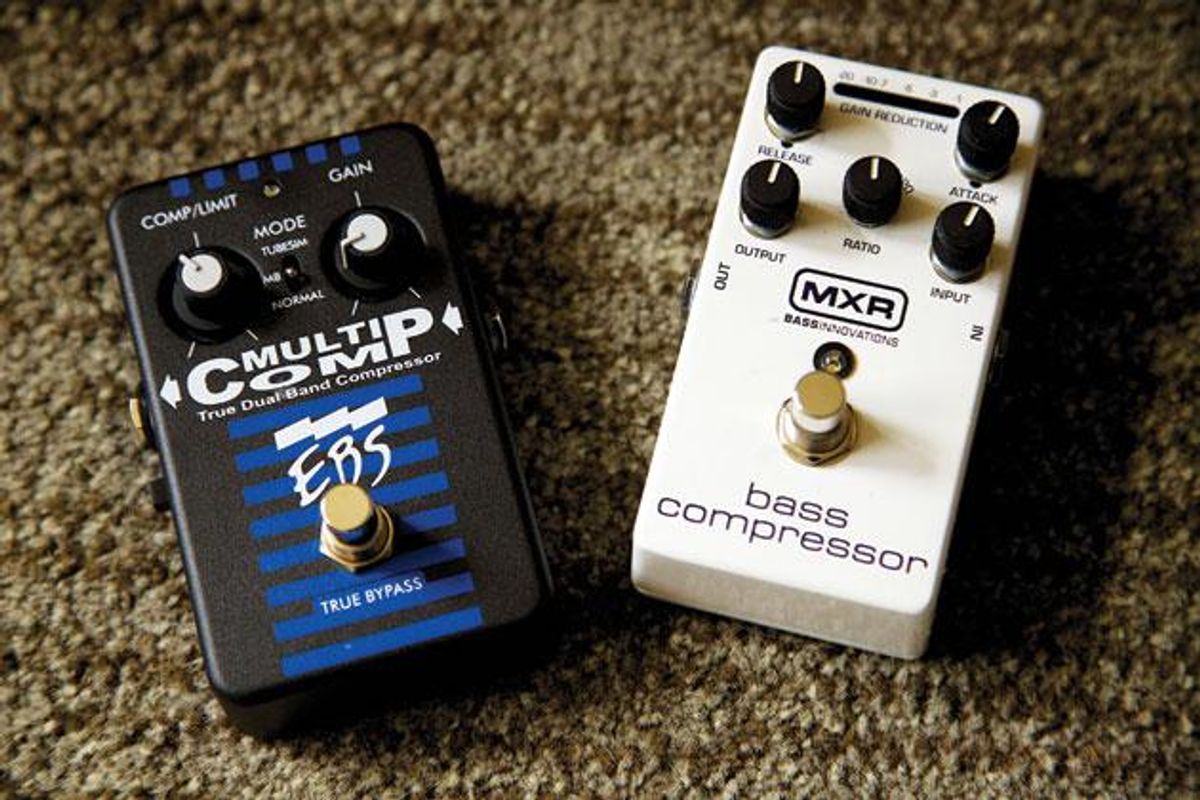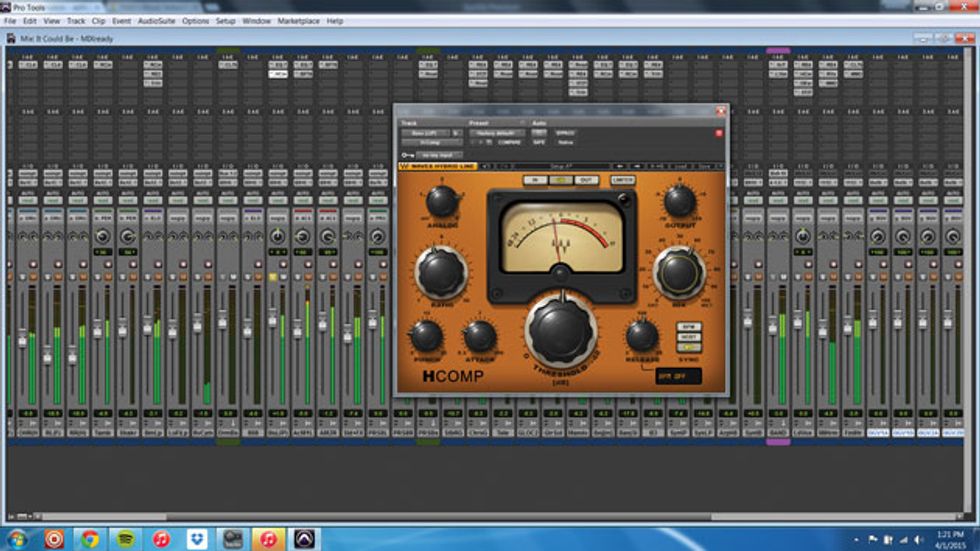
High-quality compressor stompboxes have increased in number in recent years, and the amount of control over
the effect varies from pedal to pedal.
Don’t write off compression—embrace it and use it to your advantage.
Over the past 15 years, there's one pedal I've done very few shows without. And we're literally talking over a thousand different shows with countless different artists. I've worn out several duplicates of the same pedal, because once I got used to playing with it, I simply couldn't play without it. What pedal? An old EBS compressor. Onstage or in the studio, compression is a vital tool for many bassists, yet it's still misunderstood by many others.
Onstage. I use a fairly subtle setting on my dual-band compressor pedal when performing live. And I use it primarily as a tool to even out the volumes between the strings and add a punch that helps me be heard in the mix, not just felt. Many FOH engineers are forced to use a lot of compression on inexperienced bassists because of the unevenness of their attack. That said, achieving an even attack as a bassist is a life-long quest, and I still practice at home through an amp without my compressor so I can catch any volume inconsistencies in my playing technique.
In the studio. Here, compression is a necessity for bass and there are lots of opinions and theories on how to do it best. To shed light on the subject, I've asked three world-class Nashville engineers—Mitch Malloy, Anthony Rankin, and Pat Lassiter—to share some of their thoughts on compression using outboard units and plug-ins. Because most of us do a lot of tracking at home, knowing how to compress your bass using a plug-in is an essential skill.
Outboard Compressors
Malloy: I generally track bass through my Tube-Tech CL 1B compressor. I find that if you have the right compressors, you can track with them, though I warn new engineers to not use compression at all when tracking, if cheap compressors are the only option. You'll stomp on the audio coming in and you can't get that sonic richness back once you diminish it. My compression ratio for bass is usually 3:1 going in, and the treatment of attack and release depends on the bass, the player, and the song.
Lassiter: Unless you are mixing the tune yourself, I would suggest not using much compression at all for tracking. This way the mix engineer can do what he feels needs to be done at the mixing stage. For a lot of different songs—regardless of style—I like using a vintage UREI 1176 “Rev F" with a 4:1 ratio, a slow attack setting, and generally a fast-release setting. I get the needle to move slightly on the 1st string so it efficiently evens the peaks the 5th string creates. Then I do the final compression while mixing. The Tube-Tech CL 1B is another one of my favorites because it offers a smoothing tube sound.
Rankin: Because of its quick attack, I dig what an 1176 or similar compressor does to bass—especially for faster patterns or slap parts. I use an 8:1 ratio on an 1176 and will usually drive the input fairly hard (around noon or 1 o'clock) for a passive bass, and then set the output accordingly. I also use a Focusrite ISA 430. It has less character than an 1176, but offers more parameters. For band tracks, I use a medium compression setting. I don't necessarily want to hear it working, I just want it to subtly even out the peaks and valleys and extend notes that might not have an intrinsic sustain.
Bass compression is absolutely essential for recording, and engineers rely heavily on plug-ins—
especially in the mixing phase.
Plug-ins
Malloy: I often use plug-in compression in the mixing stage because I use an outboard piece in the tracking phase. I like the Tube-Tech CL 1B plug-in and I generally use higher ratios when mixing—up to 5:1 when necessary—than I use when tracking. My new favorite compression to use for bass is in the Slate Virtual Mix Rack.
Rankin: My favorite plug-in is the Waves JJP Bass. Instead of numerical ratios, the parameters work based on terms like sub, presence, and length, so it's musician friendly. This compressor lets me get a beefy sound without having to squash the bass track too much. I typically set the sensitivityknob between noon and 2 o'clock, and the comp setting somewhere between 10 and 2 o'clock. Another compression plug-in I often use for bass is the Waves H-Comp, and the sweet spot for it is always around 5:1 or 6:1. My favorite part about the H-Comp is its ability to mix wet and dry signals like on some hardware-compressor stompboxes.
Tip: The key is to listen carefully when using compression, so simply take the aforementioned suggested settings as a starting point. A basic understanding of compression will help provide more glue, consistency, and punch to your in-home bass tracks and make them sound a lot more “pro."


